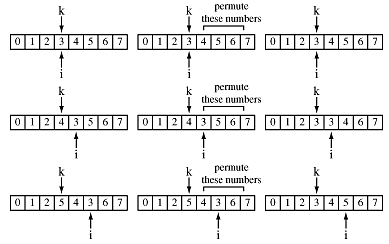
[WPI] [cs2223] [cs2223 text] [News] [Syllabus] [Classes]
In Class 24 we introduced the N-queens problem. In this class we discuss how to solve it and related problems.
If there are N2 squares on the chessboard and N queens, there are

ways to place the queens. Most are not solutions to the problem. We could just calculate them all and throw aways non-solutions. Unfortunately, this is a large number. For a standard 8x8 chessboard, it is

This number grows very rapidly with N.
We can reduce the number of cases by noticing that the solution will contain no two queens in the same row or column. Thus we can create a vector of column numbers:

Then each permutation of this vector represents a different arrangement of the queens - it tells us column number of the queen in each row:
![for 0 <= k < N, row(k) = k, col(k) = C[k]](eq26_04.gif)
Since there are N! permutations of the vector, that is the number of possible chessboard arrangements. For a standard chessboard, this is:

That is better, but we still need a way to find (and eliminate) trial solutions.
First, we look at a recursive way to calculate the permutations of the vector C. We use this function
permute(int start, int length, int *vector);
Which starts at some position in the vector and permutes what
comes after it:
in the vector and permutes what
comes after it:

This is done by sequentially swapping k with each , permutting everything
to the right of k, then swapping back. Here are the first few operations
of this algorithm.
, permutting everything
to the right of k, then swapping back. Here are the first few operations
of this algorithm.

And here is the code for the function.
void permute(int k, int n, int *vec) // calculate permutations of a vector
{ // n is the length of the vector, k is the position to begin permutations
if (k >= n-1) return; // permutation is complete
for (int i = k; i < n; i++)
{
int temp = vect[k]; vect[k] = vect[i]; vect[i] = temp; // swap
permute(k+1, n, vect); // recursive call
temp = vect[k]; vect[k] = vect[i]; vect[i] = temp; // swap back
}
} // end permute()
The attached script shows that this function produces the proper results. Note, the first line in the program can be uncommented to print ou the values, as shown in this script. But, be careful. The number of printed lines can be quite large.
The N-queens algorithm does the following:
This algorithm is of order O(N!) because that's how many permutations there are. The actual number is somewhat less since the algorithm terminates once the first solution is found. We can speed up the algorithm somewhat by noting that any partial solution (we're checking one of the middle queens) only works if the queens above it already have successfully passed the "no diagonals" test. So, we modify our algorithm:
![Figure showing a portion of a chessboard witha queen in row k and column C[k]. In terms of the C[k] vector, k points to an element. Everything to the left is the queens above it; everything to the right will be later queens - they can be ignored.](fig26_03.gif)
We only have to look at the rows above the queen we are trying to place - that means we only need to look at values of C which come before C[k]. If the queen in the row above is on the 45° diagonal, it's column value C[k-1] will be one larger than C[k]. Similarly, if it is on the 135° diagonal, it's column value C[k-1] will be one smaller than C[k]. A conflicting queen two rows above will have C[k-1] values two larger or smaller than C[k-1], and so forth.
We can use this test for conflicts between the k-th queen and the earlier i-th queen:
if ((column[i] == column[k] - (k - i)) || (column[i] == column[k] + (k - i))) // conflict
This code returns one when the gloabal vector columns[]
contains a solution or zero otherwise.
int queens(int k, int n) // N-queens test
{ // n is the length of the vector, k is the position to begin testing
if (k == n) return 1; // checking is complete - the solution has been found
for (int j = k; j < n; j++) // otherwise, permute and check the following queens
{
int temp = column[k]; column[k] = column[j]; column[j] = temp; // swap
int conflicts = 0; // flag to keep track of conflicts
if (k != 0) for (int i = k-1; i >= 0; i--) // don't need to check when k == 0
{
counter++; // keep track of diagonal tests
if ((column[i] == column[k] - (k - i)) || (column[i] == column[k] + (k - i))) // conflict
{
conflicts = 1;
break; // no need to look further
}
}
if (!conflicts && queens(k+1, n)) return 1; // solution found
temp = column[k]; column[k] = column[j]; column[j] = temp; // not found, swap back
}
return 0; // no solution found
} // end queens()
The attached script shows that this function produces the proper results. Notice that the number of comparisons is far fewer than N!.
![]()
![[WPI Home Page]](../../images/wpi_logo_small.gif) |